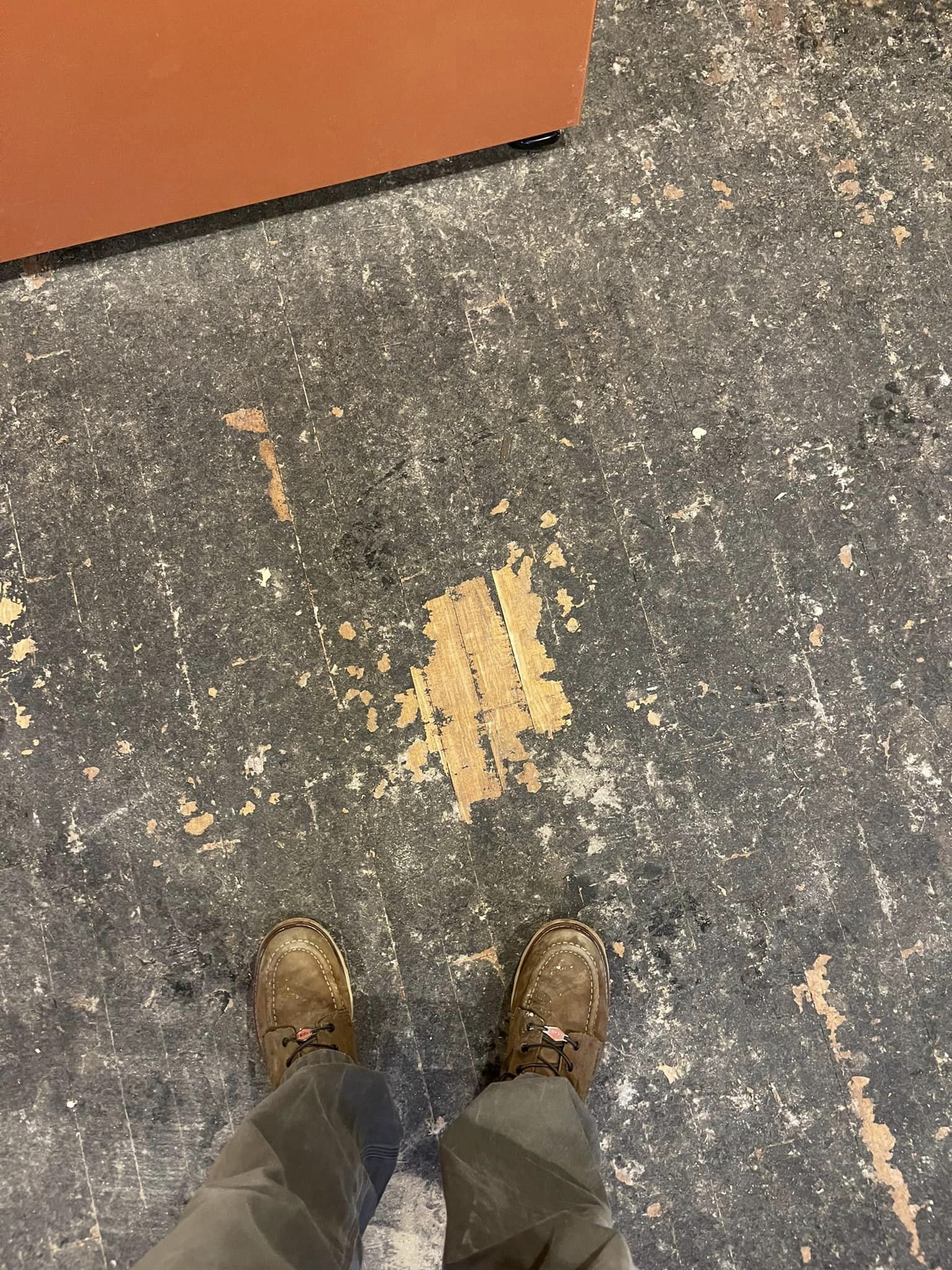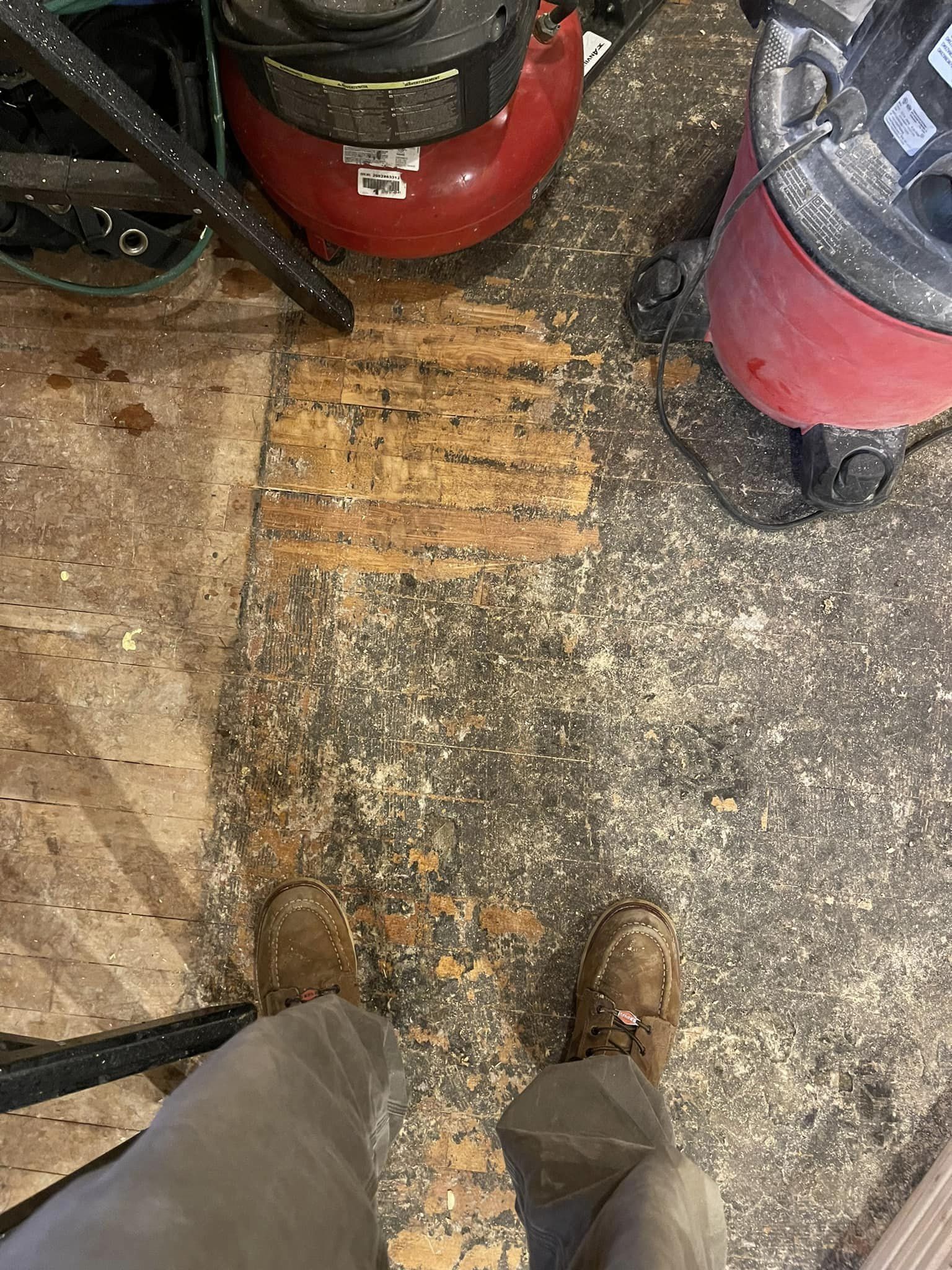Is there a chemical stripper or alternative method to remove nasty tar paper without scraping it off during kitchen renovation?
11 months ago
Last Updated: July 27, 2024
Hey everyone, I’m currently redoing my kitchen and I really want to refinish my hardwood floors. The only issue I’m facing is this stubborn tar paper that’s been glued down. Does anyone know of a way to remove it without having to scrape it off? Maybe a chemical stripper or something like that? I remember seeing a similar question on a forum, but I can’t recall if it was in this group or not. Any advice would be super helpful! Thanks in advance!


Have you considered using a heat gun?
Had around a MONTH to complete it
Just one thing to clarify – is there asbestos present?
This is the product we used. It’s quite strong, so be cautious not to damage the wood. Some have suggested it could have asbestos. Take that into consideration, but I’d recommend wearing a respirator at the minimum.
We tried the Orange cleaner from Dollar Tree. Just spray, wait about 10 minutes, then scrap off. It’s a bit messy but it did the job nicely.
Have you thought about hiring a professional to do a dustless sanding on your wood floors, and then you can refinish them on your own?
I think the most effective method is to use a rental machine and an edger to sand them down, followed by a buffing machine with sanding screens to remove any dust before applying a stain or clear finish. It’s definitely a lot of work, but the end result will be a professional-looking job. Alternatively, you could consider hiring someone to do the work for you. When removing the tar paper and cleaning everything up, you may discover areas that require more attention than just peeling. Good luck with your project!
The amount of sanding disks you’ll need largely depends on how dry the tar paper is. If it’s not dry, you’ll end up using a lot of sanding disks, which can be costly at $15 each
The machine you can rent for this job is a drum sander with 20 or 40 grit sandpaper, followed by higher grit belts or disks on an edger. You start with 20 or 40 grit for the rough work, and it lasts a long time. The edger removes black glue and tar paper along the walls, with disks costing a bit over a dollar each. The drum sander covers the large floor area, and the low grit belt should last through the initial sanding to reveal the wood. Then you switch to higher grit papers for a smooth finish, and use sanding screens on a buffing machine for an even finer touch. These screens can be bought for around $8.00. If you’ve already tried chemical removal or other methods, the floor finish may not be salvageable, so refinishing is likely necessary. After removing the black substance, you might only need a buffing machine and sanding screens. Avoid the hassle of chemicals and the challenge of cleaning them out of the wood to prep for polyurethane.
I’ve been getting rid of ceramic tile to make way for new flooring. The grout has to go! The guy at the rental place warned me that the floor sander might ruin my sanding belt, but it held up just fine. It might get a bit sticky, but it’ll get the job done. I used my small belt sander for tight spots and edges along the walls.
I removed old linoleum from a hardwood floor in a historic 1890 house. I sprayed vinegar directly on the floor and let it sit for a bit. It turned into a sticky goo that I could easily scrape off with a plastic tool. I had to repeat the process in some spots.
Make sure to have it checked for asbestos first, especially if you care about your health.
By the way, use black mastic.
When you’re refinishing, you’ll need to use a drum sander at some point. Begin with a really coarse grit to get rid of the tar paper with the drummer, then proceed as normal.
I opted for a non-toxic mastic remover, which did the job effectively, albeit at a slow pace.
If possible, try to steer clear of methods that create dust – asbestos issues stem from breathing it in. If the more gooey options don’t do the trick, it might be best to bring in a professional for sanding. They’ll have the proper safety gear.
We tried that out, but the only thing that did the trick was using 36 grit on a drum floor sander.
No content
No content
This was our first time trying this….it was quite laborious 😅
This particular product is great for getting rid of old paint, glue, linoleum, and even skin. Just a heads up, regular rubber gloves may not last very long.
Do you think this is actually tar paper? Was there tile or sheet flooring on top of it? It’s hard to tell if it’s really paper remnants since there is no flaky appearance, unless you already removed the loose bits. To me, it seems more like mastic adhesive. Before using a sanding machine on it, you might want to have it checked for asbestos contamination. In the past, mastic adhesives sometimes contained asbestos, which can be dangerous if you abrade it mechanically. It’s worth verifying. Additionally, there are cleaners made from soy or vegetable oil that can soften mastics and mastic-based paper products, allowing you to use scrapers to clean up this type of mess. You may need to make two or even three applications to finish the job. These cleaners will make it easier to wash off the final residue with soap and water. It’s a bit messy, but much safer than the dust generated during sanding. Of course, you will still need to sand and fill the floors for refinishing after this initial step. I would also like to mention that it is rarely pointed out here, the importance of dust control during floor refinishing, as the dust created can be highly flammable and, depending on the original finishes used, toxic and/or irritating to the lungs. Make sure to wear proper respiratory protection when sanding these floors.
You should consider renting a large floor sander from a place like Lowe’s.
When using a drum sander with 32 grit sandpaper, you’ll go through a lot of sheets. It’s best to wear a respirator dust mask, specifically one with a silicone mask and replacement filters. ‘t forget, if you need to sand edges, it’s worth renting a specialized sander to avoid unnecessary risks to your health.
Before you get started, make sure to test a small section for asbestos so you’re not spreading it around your house while sanding. If you’re dealing with residue on the floor, try mineral spirits first, let it soak in, then scrape it off. If that doesn’t work, lacquer thinner might do the trick. Remember to let the floor dry completely before moving on. These solvents are flammable, so be sure to use them in a well-ventilated area with protective gear. If all else fails, you might need a chemical paint stripper. Eventually, you’ll have to sand the floors – a typical sequence is 40-60-100, but start with a 20 if needed. Just be careful not to overdo it.
Start with a 30-grit commercial drum sander.
You really should begin by using a drum sander on that floor to get the job done quickly, then switch to a stand-up commercial orbital sander.